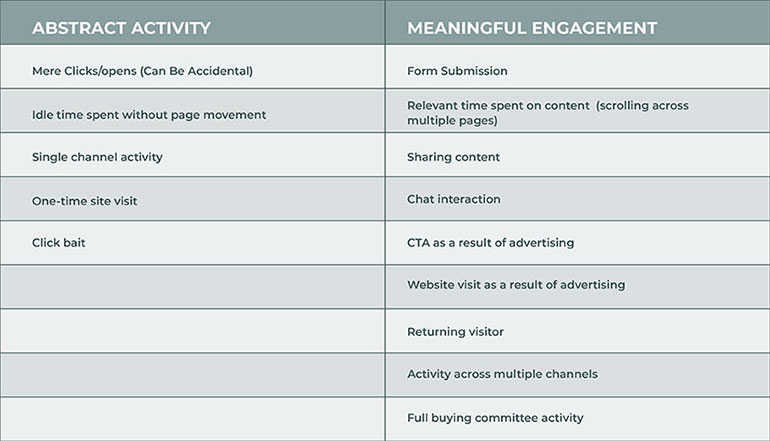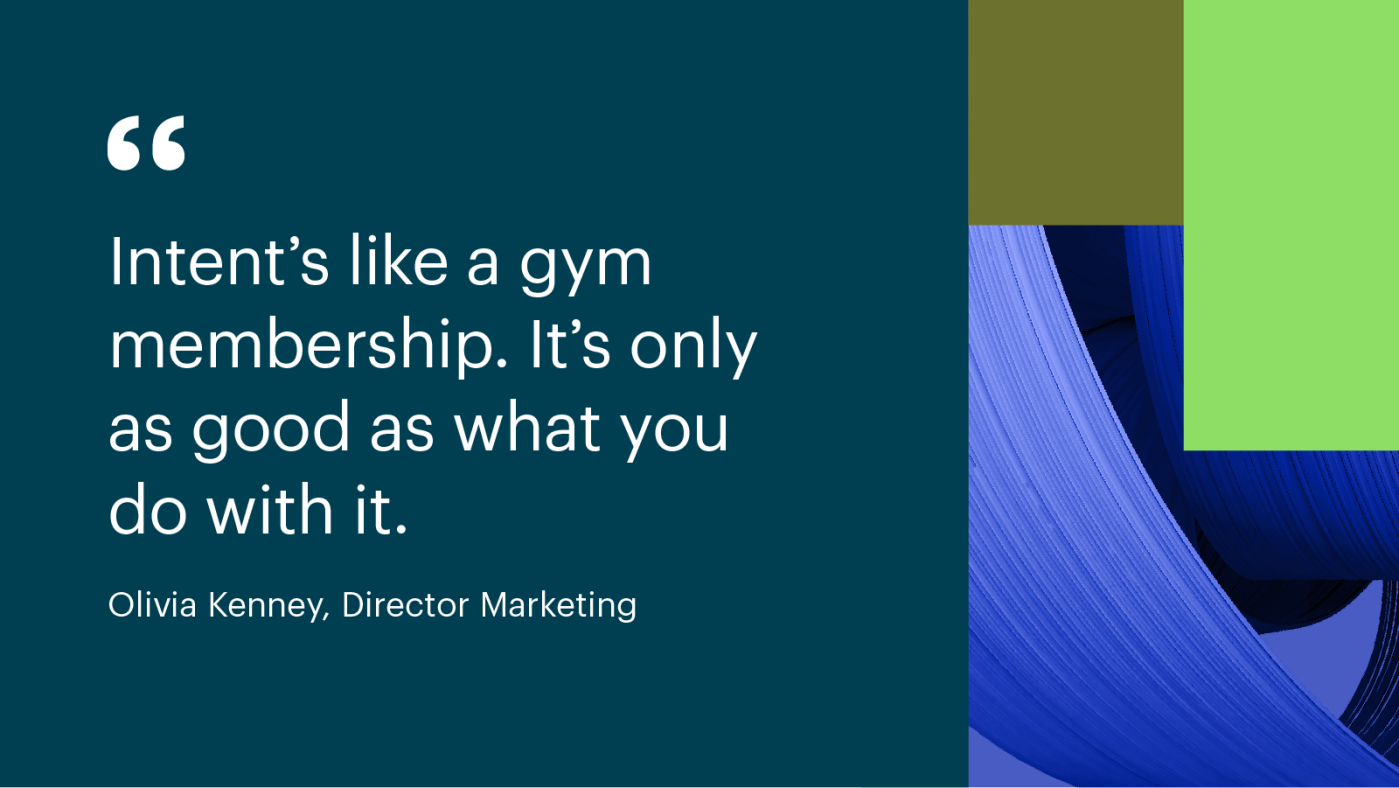As a marketer, your goal is to learn enough about your prospects from campaign activities to facilitate productive conversations that drive growth. So how do marketers use intent data and engagement insights to reach that goal? In this blog, we discuss the difference between intent and engagement, how intent can be used to facilitate engagement, and why engagement is a KPI that marketers should pursue.
Intent data serves a unique purpose
What is intent data, and how does it deliver on the promise of marketing?
Intent indicates which topics a buyer is interested in and what kinds of products or services they might be looking for. Marketers care about intent because it acts as a beacon, pointing them in the right direction during a lead gen campaign.
Definition: intent data tells us what a buyer is interested in (topics) and helps marketers who sell in those categories persuade the buyer to act
By considering intent, marketers can understand, for example, who might be looking to purchase new project management software. Perhaps the buyer read a few articles titled “How to Budget for Project Management Software” and “The 6 Best Project Management Tools for B2B.” Based on this content consumption and similar browsing behavior, we can assign some level of intent that indicates the buyer is looking to buy new project management software.
Of course, intent signals can vary in significance. If a buyer clicks one email CTA, this is not solid enough data to truly qualify the lead. But take an e-commerce shopper for example. If the buyer adds a product to their cart, this clearly indicates an intent to buy. If the buyer leaves the product in their cart for some time, then this is the perfect opportunity to reach out with a nudge email. If the buyer is browsing competitor content, it’s also a good opportunity to send them your content so they can weigh all their options when it comes to decision time.
In a marketing context, we can see why intent data is so valuable. Marketers use this information to choose whether to continue nurturing the buyer down the funnel or directly reach out.
But intent is just the tip of the iceberg. Engagement—the measure of actual, human interaction—is what marketers want. While intent data can be used to inform and activate campaigns, engagement applies that data to brand-specific content, products, and timely activity. The main question is: “how can I use intent data to generate engagement?”
Engagement is the marketer’s end goal
Consider again the buyer looking for project management software. We’ve collected intent data based on their browsing preferences, research behavior, etc. This is the starting point. Then, we need to measure their individual actions to see if they’re interested in YOUR software. You can begin to see how we use intent data to activate engagement.
Think of it like this:
- Intent is a quantitative way of sorting data, which can be collected and stored for a while
- Engagement is qualitative in that is consists of more dynamic, meaningful activity
Engagement tells a story about a buyer’s relationship with the brand and their investment in it. While intent allows marketers to activate campaigns, engagement takes us across the finish line.
Definition: engagement is a metric used to understand the buyer’s awareness of and demand for a brand, reinforced by high-quality digital actions across multiple channels
Because engagement tells a richer story about the buyer, it is a justified, legitimate, and highly successful way to qualify leads.
In the world of lead gen, engagement is critical to measure for three main reasons:
1. It provides a source of truth on the buyer journey
Engagement tells a story. It shows exactly how buyers engage with your content and how invested they are in your brand.
2. It connects the marketing funnel to the sales pipeline
We use engagement to understand how a buyer moves down the funnel, bringing context to every sales conversation. Could the struggle to align sales & marketing finally be over?
3. It’s qualitative and dynamic
Intent can be stored over time, but engagement shows the most accurate picture of the buyer in real-time throughout the buying process. Plus, it builds over time.
It’s important to note that measuring engagement does not mean taking a best guess at determining a buyer’s feelings; it can actually be observed through digital and human-verified actions. Perhaps the best way to understand what engagement signals look like is to posture them against the metrics that we’re used to seeing: abstract activity.
Abstract activity includes random clicks, one-time site visits, idle time spent on a page without moving. In other words, these are not actions that we would consider acceptable to qualify a lead, yet these are the only metrics that most of our tools and vendors make available to marketers at the end of a campaign.
On the other hand, meaningful engagement includes chat activity, content sharing, considerable time spent on an asset, activity across multiple channels, etc. When a buyer consumes multiple pieces of content from one brand— staying on the page for a minute or so—and views the company’s website, this is meaningful engagement. Furthermore, marketers can deliberately measure engagement by looking at activity, opposed to looking at high-level intent topics.

Better together: use intent data to achieve real engagement
Though the difference between intent and engagement is subtle, it is important to consider in the scheme of identifying and qualifying leads. Intent is part of the story but not the whole story. Engagement is where the truth lies, and marketers should measure it with precision and care.
Intent data is a valuable tool for marketers. We use intent data to understand a buyer’s preferences and behavior. We use it to activate campaigns. But engagement is a KPI, a metric used to assign value to the buyer’s actions.
✓Marketers should use intent data to activate their campaigns at the onset and measure engagement throughout. Together with other campaign parameters (demographic, firmographic, technographic), use intent data to trigger a series of content marketing and programmatic campaigns. What is an end point for many lead gen vendors should be the starting point.
✓After the campaign activates, pursue engagement. Marketers can use predetermined lead qualification standards based on how the lead engages with their brand and their brand alone. Don’t just consider engagement via email. Use the same (first party) dataset to capture engagement across multiple channels. This allows marketers to see if the same buyer consumes a client’s content via email and on their website.
✓You can also use engagement to trigger buying committee outreach. When the primary buyer engages with a brand via email, launch a series of programmatic programs to get the rest of the buying committee warmed up to the brand. These activations count on engagement to be successful.
Intent and engagement work better together. Intent informs the campaign and helps to narrow down parameters —ultimately saving time and money. Engagement qualifies leads by actual interactions with a brand and their products or services. Together, they will yield better quality marketing leads and a stronger sales pipeline.







